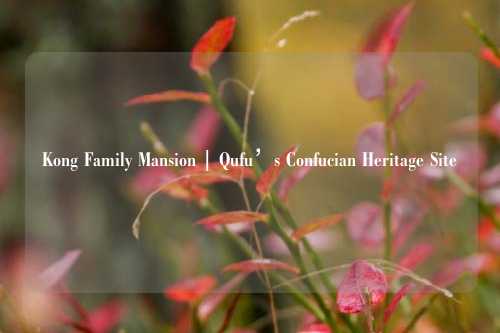Kong Family Mansion | Qufu’s Confucian Heritage Site
Nestled in the heart of Qufu, a city steeped in history and culture, lies the Kong Family Mansion, a testament to the enduring legacy of Confucianism. This grand architectural marvel not only served as the ancestral home of Confucius’ descendants but also stands as a symbolic landmark of China’s rich heritage. In this article, we explore the historical significance, architectural grandeur, and influence of the Kong Family Mansion, offering a deeper appreciation for the values it represents.
The Historical Significance of the Kong Family Mansion

The Kong Family Mansion, also known as the Confucian Mansion, is one of the most significant historical sites in Qufu, Shandong Province, China. It is not just a building; it is a living museum that tells the story of Confucianism’s impact on Chinese society for over two millennia. The mansion has been the ancestral home of Confucius’ descendants for more than 2,500 years, making it one of the oldest continuously inhabited family residences in the world.
The origins of the Kong Family Mansion can be traced back to the Spring and Autumn Period (5th century BCE), when Confucius, the iconic philosopher and founder of Confucianism, lived in Qufu. After Confucius’ death, his descendants continued to live in Qufu, gradually expanding and renovating their family home over the centuries. The mansion was not merely a dwelling place but also a center of learning, where Confucian思想 was preserved, studied, and passed down through generations.
During the Han Dynasty (206 BCE – 220 CE), Confucianism became the official philosophy of China, and the Kong Family Mansion gained even greater significance. The empire recognized the importance of Confucius’ teachings, and the mansion was refurbished and enlarged to reflect its elevated status. The mansion became a symbol of the enduring influence of Confucianism and a place of reverence for scholars and officials alike.
Over the centuries, the Kong Family Mansion survived numerous wars, natural disasters, and social changes. It was repeatedly restored and expanded during the Tang, Song, Ming, and Qing Dynasties, with each period adding its own architectural elements and artifacts. By the time of the Qing Dynasty (1644 – 1912), the mansion had grown into a vast complex of nearly 600 rooms, spanning over 150,000 square meters. It was a feat of architecture and engineering, showcasing the wealth, power, and prestige of the Kong family.
Today, the Kong Family Mansion stands as a UNESCO World Heritage Site, along with the nearby Confucius Temple and the Kong Family Cemetery. Together, these three sites form a triad of and historical significance, illustrating the deep-rooted connection between Confucianism, the Kong family, and the Chinese people. The mansion is not only a repository of Chinese history but also a place of spiritual enrichment, offering visitors a chance to reflect on the timeless principles of Confucianism.
The Architectural and Cultural Marvel of the Kong Family Mansion
The Kong Family Mansion is a masterpiece of Chinese architecture, reflecting the tastes, beliefs, and values of the Kong family over the centuries. Its design is a harmonious blend of functionality, aesthetics, and symbolism, with every detail ly planned to convey a deeper meaning.
The mansion’s layout is centered around a series of courtyards, which are arranged in a logical and hierarchical manner. The outer courtyards are reserved for official and ceremonial functions, while the inner courtyards are more private and reserved for family use. This division reflects the Confucian emphasis on order, respect, and hierarchy, with the outer spaces symbolizing the public duties of the Kong family and the inner spaces representing the private sphere of family life.
The architecture of the mansion is characterized by its elegant and balanced design, with elements like sloping roofs, ornate pillars, and carvings. The roofs are typically covered with yellow tiles, a color reserved for imperial and Confucian institutions, underscoring the mansion’s prestigious status. The pillars are adorned with elaborate dragon and phoenix carvings, symbolizing strength, power, and prosperity.
Inside the mansion, the interiors are equally impressive, with elaborately painted ceilings, calligraphic inscriptions, and works of art. These decorations not only showcase the artistic skills of China’s craftsmen but also serve as a visual representation of Confucian teachings. Calligraphic inscriptions, for example, often feature passages from Confucius’ writings, emphasizing themes of morality, integrity, and self-improvement.
One of the most striking features of the Kong Family Mansion is its vast collection of historical artifacts, which includes ancient books, paintings, sculptures, and ceremonial objects. These items are not merely decorative; they are a testament to the mansion’s role as a center of learning and preservation. The library, in particular, is a treasure trove of Confucian texts, including rare manuscripts and editions of the Analects of Confucius, which are of immense historical and scholarly value.
Beyond its physical structure, the Kong Family Mansion is also a place of spiritual significance. It is a reminder of the enduring influence of Confucianism, which has shaped the moral and ethical framework of Chinese society for centuries. The principles of Confucianism, such as respect for elders, loyalty to the state, and the importance of education, are deeply ingrained in the values of the Kong family and the Chinese people as a whole.
In recent years, the Kong Family Mansion has also become a popular tourist destination, attracting visitors from around the world. Tourists come not only to admire the mansion’s architectural beauty but also to learn about the rich heritage it represents. The mansion offers a glimpse into the lives of Confucius’ descendants and the values they have preserved over the centuries. It is a place where the past and present converge, offering a window into the heart of Chinese culture.
, the Kong Family Mansion is much more than a historical site; it is a living testament to the enduring legacy of Confucianism and the indelible mark it has left on Chinese civilization. From its stunning architecture to its rich artifacts, the mansion is a place of inspiration and reflection, inviting visitors to explore the timeless principles that have shaped the lives of generations. Whether you are a history enthusiast, a culture lover, or a philosopher at heart, the Kong Family Mansion is a must-visit destination that promises a and enriching experience.
















